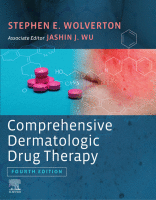Physical Address
304 North Cardinal St.
Dorchester Center, MA 02124

Questions Q42.1 What are primary examples of topical antifungal agents from the following categories: (1) polyenes, (2) azoles, (3) allylamines, (4) benzylamines, and (5) hydroxypyridones? (Pg. 480, Table 42.1 ) Q42.2 Although azole and allylamine antifungals both block ergosterol synthesis,…

Questions Q41.1 How effective is bacitracin versus mupirocin in eliminating nasal staphylococcal carriage? (Pgs. 466, 470) Q41.2 Concerning postoperative topical antibacterial use, (1) what are the pros and cons of routinely applying petrolatum versus a topical antibacterial agent for ‘clean’…

Questions Q40.1 What are several important drug interactions with anticholinergic drugs discussed in this chapter? ( Pg. 446) Q40.2 What are several factors which increase the risk of myopathy from attenuated androgens? (Pg. 447) Q40.3 What are some of the…

Questions Q39.1 What is the most important adverse effect from the most potent bisphosphonates (such as etidronate)? (Pg. 431) Q39.2 What are the mechanisms of action by which bisphosphonates prevent and treat osteoporosis? (Pg. 431) Q39.3 What are the reasons…

Questions Q38.1 What are the US Food and Drug Administration (FDA)-approved indications for vismodegib and sonidegib? (Pg. 422×2) Q38.2 What are the various off-label uses for Hedgehog (Hh) pathway inhibitors? (Pgs. 423×4, 424×3) Q38.3 What are potential adverse effects of…

Questions Q37.1 What are several drugs commonly associated with mucositis? (Pgs. 406, 409, 414, 415×2, 416×2) Q37.2 Which drug class is most commonly associated with an acneiform papulopustular eruption? (Pg. 406) Q37.3 What is the time course of the papulopustular…

Questions Q36.1 What are the mechanisms by which intravenous immunoglobulin (IVIg) affects (1) antibody (Ab) production, (2) Ab neutralization, (3) the complement system, (4) T-cell activation, (5) immune cell trafficking, and (6) Fas/Fas ligand interaction? (Pg. 398) Q36.2 What is…

Questions Q35.1 What are the four main categories of psychodermatologic disorders? (Pg. 383, Fig. 35.1 ) Q35.2 What are the four major underlying psychopathologic conditions upon which the medication choice is decided (what is the ‘fifth’ nonpsychiatric category of interest)?…

Questions Q34.1 What is the difference between an ‘antiandrogen’ and ‘androgen inhibitor’? (Pg. 367) Q34.2 For which skin disorders are antiandrogens and androgen inhibitors clinically useful from a mechanistic standpoint? (Pgs. 367, 368) Q34.3 What are the key differences in…

Questions Q33.1 What are several of the important nitric oxide releasers involving cutaneous vasculature? (Pg. 359, Table 33.1 ) Q33.2 Which drugs discussed in this chapter have demonstrated efficacy in patients with Raynaud phenomenon? (Pgs. 359, 364×3, 365, Box 33.1 )…